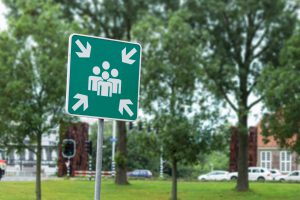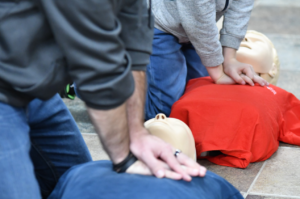After a year and a half of pandemic, you’ve probably had to adapt your evacuation drill planning. Some companies have even stopped conducting drills altogether. But now, the time has come to review how best to comply with regulations while avoiding workplace outbreaks.
Our emergency measure specialist team recommends the following three approaches:
1. Conduct a standard evacuation drill

That’s right. It’s now possible to conduct a standard evacuation drill! Consider this option if you have a small two-storey commercial building or a small industrial site. This type of drill may also be a suitable solution for a high-rise building with a low occupancy rate.
We recommend consulting a professional before preparing a standard evacuation drill. Also, it’s advisable to focus on the following practices in the current context:
- Inform participants of the date and time of the drill so that they know to keep a procedure mask close to hand. Then, if some people aren’t comfortable participating, they can make an informed decision and leave the building early or telework on that day.
- Before the drill, make sure everyone knows they’ll need to wear a mask and maintain physical distance throughout the drill, both in the stairwells and at the assembly point.
2. Conduct a tabletop drill

The tabletop drill is accessible to all workplaces and is a simple way to practice all stakeholders’ tasks without a great deal of preparation.
The idea is to develop a small scenario from the emergency measures in place in the building and to have the emergency responders practice, minute by minute, how such a situation would unfold. These exercises can be carried out by video conference or around a meeting table.
3. Conduct a mock drill

The mock drill falls midway between a tabletop drill and an evacuation drill and involves preparing one or more scenarios to practice building emergency measures.
Stakeholders will need to take concrete action, including communicating by radio, looking for information in the Fire Safety Plan, go to the site where the fire was detected if required, etc.
This type of drill provides stakeholders with hands-on experience to practice their tasks and makes it easier to assimilate required procedures.
Keep the following in mind no matter the type of drill you choose
-
- In pandemic times, you must be comfortable with the drill’s risk of spreading COVID-19 to take responsibility if such an outbreak occurs, as is the case for any other activity conducted on your premises. If you aren’t comfortable with your first choice, choose another option.
- Seek professional advice to assess your situation. You should proceed on a case-by-case basis. You’ll get customized support based on the approach you choose, and you’ll feel less pressure and stress.
- Write an evacuation report following your drill to perform the appropriate follow-ups and also prove to the various private and public authorities that you have conducted an annual or biannual regulatory drill, depending on the occupation of your building.
For more information on our rates and how to prepare drills, click here to book an appointment with our Director, Security and Emergency Measures.




